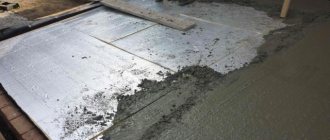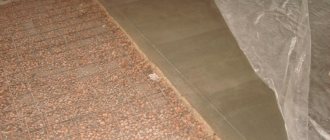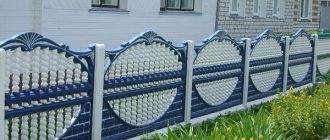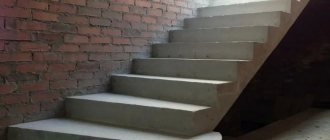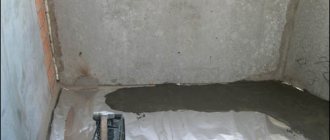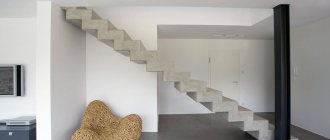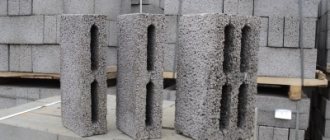How does a self-leveling floor differ from a leveler?
When searching for “self-leveling floor,” the search results in bathrooms and toilets with images of the jungle, clouds, or seabed on the floor. In practice, instead of paintings, masters pour some kind of gray liquid mixture.
A self-leveling floor is usually called a method of leveling horizontal surfaces when the plane is filled with liquid cement-based binder. Since the mixture is liquid, it always forms horizontally. A perfectly flat surface subsequently allows you to perform any type of finishing, from tiles to gluing prints with images.
Manufacturers often name these materials differently, which often gives rise to many misconceptions. For example, instead of the name “self-leveling floor,” the bag may say “self-leveling mixture,” “liquid leveler,” etc.
In the box: Knauf uses the name “self-leveling mixture”. Ceresit uses the phrase “thin-layer leveler”, Weber often uses the more familiar designation “self-leveling floor”.
Leveler the name can mean both a mixture for a self-leveling floor and a “classic” cement-sand screed.
Wooden or concrete floor in a private house
Recently, even in private homes, concrete floors have become increasingly common. It's all about the capriciousness of wood. The first thing that is important is that wood needs regular care. If larch or oak is not used, after a few years the appearance leaves much to be desired. Again the floor has to be sanded and covered with oil/wax/paint/varnish. The second drawback is squeaks. A squeak-free wooden floor is a rarity. The third point: of course, it is possible to lay tiles on a wooden floor, but the solution is not cheap - you need elastic glue, but it costs a lot. In general, after living with a wooden floor for some time, they decide to replace it with a concrete one. It has its own “charms”, but it is easier to use. Only if it's done correctly.
This is not at all what one imagines when hearing the words “wooden floor”...
The first thing to remember is that you can make a concrete floor in a private house only if the foundation can bear the additional load. If a wooden floor was laid when calculating the foundation, all you can do is a reinforced screed on the rough wooden floor. And that's in question. Most likely, you will have to simply make a dry screed on expanded clay or lay sheet material over the joists. This is, of course, not a concrete floor, but not wood either.
How do self-leveling floors differ from screeds?
In order not to make a mistake when choosing a mixture, we will consider the main differences between the two technologies.
- Rough levelers (screeds) - in most cases they are a cement-sand mixture. They allow you to form a large layer from 3 – 5 cm to 15 cm. Leveling is done manually using a rule and steel beacons, so small errors may remain. The main advantage of screeds is the low price for the material; the disadvantages include high labor intensity and a long hardening time for the solution.
It takes 28 days for a “wet” screed to gain strength. During this period, you need to periodically moisten the surface and, if necessary, cover it with film. Otherwise, the coarse leveler will not be able to gain strength and will crack.
- Liquid levelers (self-leveling floors) are modified compositions based on a cement binder. They are always more expensive than a coarse leveler, but the pouring technology allows you to get a perfectly flat surface for any coating option. In addition, drying takes several days rather than a month. From a labor-intensive point of view, leveling with a self-leveling floor is easier.
In most cases, both technologies are used to level the floor; first, the floor is raised to the desired level using a screed, and then a smooth surface is formed for subsequent laying of the finishing coating.
Key Features
A modern concrete floor is the optimal solution for arranging a durable living space. Concrete floors have a number of positive characteristics.
- It perfectly levels the surface. A level base is the key to long-term use of the finishing coating. A special technology for constructing a concrete floor makes it easy to remove unevenness and make the surface uniform.
- Allows you to raise the surface level. This is required when the base is low.
- Non-flammable It is suitable for installing heated floors. Technology to save a lot of money on heating.
- The solution can withstand heavy loads. The bottom will be strong enough to install any furniture.
- Low cost of work. The materials, tools and equipment needed to construct such a coating are inexpensive. Significant savings can be achieved by doing the work yourself.
- Moisture resistant. The solution of modern samples can be used to arrange the bottom of any type of room (living room, bathroom, toilet, kitchen).
- The material is easy to use. Making a concrete floor with your own hands is not difficult. To do this, follow the instructions.
Concrete subfloor
Foundation assessment
- Before using self-leveling floor technology, you need to correctly assess the base on which the leveler is to be poured.
- If the repair is being carried out in a new building, where there is already a “rough” screed, then you need to check its quality: look at the level and tap for the presence of internal voids. Grease and bitumen stains must be washed off the surface.
- If the new building does not have a “rough” screed, but the floor level is satisfactory, then you can immediately pour the finishing leveler.
- In houses with an old foundation, it is better to remove the covering and make a new screed. After such preparation, you can begin pouring the self-leveling mixture.
If the time for carrying out work is limited, then quick-hardening mixtures should be used. Otherwise, you will have to wait a month for the screed to gain brand strength.
- Also at this stage, the possibility of installing sound insulation and insulation should be taken into account. In this case, the thickness of the floor “pie” will need to take into account the thickness of the EPS boards.
How to do it correctly, description of technology
You can begin installing floors after installing the roof, walls and ceilings. The composition of the pie may differ in different cases. Pouring the floor with concrete is carried out:
- on the ground;
- on interfloor overlap;
- on the ceiling of the attic.
Attention! Before pouring floors in a house on the ground or in the attic, it is necessary to select materials for thermal insulation and their thickness in accordance with thermal calculations. In the case of interfloor slabs, it is also advisable to provide sound insulation.
Calculation of the amount of available flooring
All work on pouring self-leveling mixtures is carried out in one day. This means that you need to immediately calculate the correct amount of solution for the room, since there will be no opportunity to buy more and fill it later. It is also not very good if the mixture was prepared with reserve and was not completely worked out.
Errors in calculations are especially critical if the floor in the room is adjusted to the level of coverings in other rooms.
Consumption is usually indicated on a 1 meter bag with a layer thickness of 1 mm. Usually this value is given with an error, so it is advisable to check it on a small portion of the solution. To do this, you will need scales, water, a bag of dry mixture, a plastic cup and mixer, and several containers for weighing.
We need to convert the values of the ratios on the bag into a volume convenient for us. For example, if 20 kg of leveler is diluted in 5 liters of water, then we need to convert this value into grams. For convenience, let's convert liters to kilograms, we get 5 kg of water. Accordingly, the ratio is 1:4. If we take 1 kg of solution, then it will require 250 grams of liquid.
We weigh the resulting amount of liquid on a scale, then reset the device and add 1 kg of solution. Mix the solution with a mixer as required by the instructions.
With self-leveling floor mortar, it is better to use a tool that can operate at reduced speed. This mixing ensures a minimum amount of bubbles in the mixture.
To check the spreading of the mixture, you can pour 250 grams of the finished solution onto a smooth surface and wait a minute. The spread of the spot should be 25 cm.
Now you need to calculate the density of the resulting mixture. To do this, divide the volume of the container with the solution by its weight. To do this, you can use a measuring cup, the volume of which we know. Since this result was obtained for a solution and not a dry mixture, we need to exclude water from the result (with 125% water). To do this, we divide the resulting density by 1.25 (if the initial ratio of water and material was 1:4), this way we will find out the real consumption of the mixture and can compare it with the data on the bag.
If you don't have a measuring container on hand, you can use a regular plastic cup. Pour water into it and weigh it, this will be the volume of the glass.
We multiply the resulting consumption by the thickness of the floor, we will understand how much mixture will be used per 1 square meter.
The first stage is preparatory
Before starting to create a multi-layer cake of concrete floors laid on the ground, the level of groundwater is determined. This can be done by choosing one of two methods.
- The first is costly, associated with the study of the geological features of the site by specialists.
- The second method is simpler. You need to find out from local residents what the groundwater level is in a given area, dig control holes 2 meters below the foundation point, and see how they fill with water.
Having determined the groundwater, they make drainage and waterproofing that will protect the room from moisture penetration. External waterproofing of the base, creation of a clay castle around it, installation of drainage pipes and installation of wells are required. It is also necessary to install gutters.
Waterproofing the basement before installing a concrete floor
After the waterproofing work is completely completed, they move on to soil work inside the foundation.
The layer of soil on which the concrete screed cake will be laid must be well leveled and compacted. Soil compaction is necessary to increase its bearing capacity. In the place that is supposed to be filled with concrete, the soil is removed to a depth of 15-20 cm and the work area is leveled.
Leveling the soil is done roughly, because the second layer of the pie will be a cushion of sand and gravel, expanded clay, which will help to better level the surface.
Gravel bed
After the excess soil has been removed and leveled, compaction of the surface begins. It can be carried out with a metal roller. It has a long handle that allows the device to rotate freely on it. Such rollers are used by road workers when laying asphalt.
Metal skating rink
In modern construction, a pneumatic or electric device is used for compacting soil, which is offered for rent. It makes the work easier if the areas being poured are large.
Required Tools
- Mixer with the ability to operate at reduced speeds
- Long bubble level or laser level
- Brush, brush, brush or roller
- Large container for preparing the mixture. If the work is done by two people, then a second bucket will be required.
- Small water container
- Needle roller
- Wide spatula
- Beacons for self-leveling floors
- Roulette
- Scales
- Pencil or marker
- Masking tape
- Rule
The second stage - we create a cushion of sand and crushed stone
A cushion made of sand and crushed stone is a must for any premises where there was no screed before. This layer is designed to level the area being poured and to prevent moisture from penetrating upward. To install it, a polyethylene film is first laid overlapping on a compacted area, and then a layer of sand 10 cm thick is poured onto it, compacted, and filled to the required size. Then a layer of coarse crushed stone is poured and leveled. The thickness of the layer will be 10 cm. Everything is compacted with a roller.
It is not recommended to use construction waste instead of crushed stone. The layer created in this way has a weak load-bearing property, and during the operation of the house this can cause rapid destruction of the floor poured in violation of the technology.
Work progress
Primer
At the first stage, the surface should be thoroughly cleaned and dust-free. Poor cleaning may lead to cracks in the future.
Apply primer to the cleaned coating. Preference should be given to special floor products. The soil should strengthen the surface and reduce moisture absorption by the base. If a universal product is used, then the dry residue in it should be at least 14%.
There are two approaches to applying primer; you can use a roller with a long handle and a ditch; you can pour the product over the floor and distribute it with a brush. In the first case, it is important to additionally cover certain areas with a brush or brush (near walls, corners, recesses, etc.), since they cannot be processed properly with a roller. If a brush is used, primer should not leak through the ceilings.
Carefully read the instructions on the primer; the indoor conditions must meet the manufacturer's requirements. Air humidity should be 60%, optimal temperature 10 - 20 degrees. Avoid direct sunlight and close the windows to prevent drafts.
We wait for the primer composition to dry (see the instructions for the time) and begin placing the beacons.
Display of beacons
This is the most difficult stage of the work; here it is important not to make a mistake so that the floors in all rooms have the same height.
Search for the "zero mark". In this place the floor will have the smallest thickness. There are many methods to accomplish this task. In small rooms (toilet, shower) you can use a long bubble level. By applying it in different directions, you can determine which corner is more tilted relative to the horizon.
Now let's consider a more complex situation, when the floor is leveled in a large room or in an entire apartment. In this case, we place the laser level in the center of the room and project a horizontal beam onto the walls at an arbitrary height.
It is better to choose the installation height of the laser level so that you do not have to bend when taking measurements. In this case, it is advisable to select an integer height value: 50 or 100 cm.
We walk around the room and measure the distance from the beam to the floor at different points. The place with the smallest value will be the “zero mark” or the highest point.
You can use improvised means as beacons or buy ready-made plastic ones. They are made in the form of small vertical posts with markings and adhesive soles.
We install a beacon at the highest point. If we use plastic, then it is cut to the thickness of the future floor. We measure the distance from the beacon to the laser. If the level was initially set at 50 cm, then with a floor thickness of 3 cm, the distance to the beam will be 47 cm.
At other points we cut the beacons so that the distance to the laser is the same as at the “zero mark”, in our case 47 cm. For example, if from the beacon to the beam is 51 cm, then we need to cut 4 cm from it. Stands every square meter should be installed.
In order not to check each beacon with a tape measure after installation, it is convenient to make a template. To do this, let's take a rule that matches in length. In order not to spoil the instrument, stick a piece of masking tape and make a mark with a marker or pencil.
A self-leveling floor in a separate room can be poured without beacons; in this case, the desired floor height is marked using a laser level on the wall.
Damper tape. A damper tape made of foam material is glued around the perimeter of the room. If the floor thickness is less than 1.5 cm, it is not required, but in other cases it is mandatory.
Preparing the mixture
- We open the bags with the leveler and prepare the water. To ensure accurate proportions, we use scales. Avoid mixing by eye.
- To mix, use a construction mixer or a drill with a whisk at low speed.
- It is recommended to work together, so that one person kneads and the other pours. In this case, you need to prepare two containers for the solution in advance.
Do not mix a large amount of solution at once, as it will be impossible to lift a heavy bucket.
- After mixing, it is advisable to check the spread. We wrote above about how to do this.
Fill
Filling the surface with the solution itself usually does not cause difficulties. You should move from the far corner to the exit. The leveler will not always flow, so you can spread it using a wide spatula. The mixture is then spread using a needle roller.
After pouring, the window should be closed and the curtains drawn. After a day, the windows can be opened to remove excess moisture from the room. It is necessary to apply the topcoat within 3 weeks so that moisture does not have time to leave the solution.
Cutting joints in concrete
Screed concrete is a rather fragile material, strange as it may sound, and is prone to cracking. In order to limit this process, expansion joints are cut into the concrete screed. There are three types:
- insulating - made in places where the floor comes into contact with all building structures: walls, columns, and prevent the transmission of vibrations;
- shrinkage - relieve stress during drying and shrinkage of concrete, which occurs unevenly;
- structural - made in those places where there is contact between concrete laid at different times.
Seams should be cut as soon as the concrete has acquired sufficient strength, but before any cracks appear. The location of the seams is marked with chalk, they are cut in the order in which the concrete was laid. The cutting depth is approximately 1/3 of the thickness of the concrete screed. To make it easier to care for the seams and strengthen their edges, seal them. The type of sealant is selected depending on the operating conditions and the expected load on the floor. Before sealing, the seam is thoroughly cleaned of dust and debris. After carefully completing all the steps, the screed is allowed to harden and dry.
Concrete floors are simply necessary where high loads on the floor are expected
Stage four – setting up beacons
Work on placing beacons begins with determining the horizontal. An assistant in this process is a laser or water level. Having chosen the desired height, strike the zero level around the entire perimeter.
Determining the difference in height fluctuations when creating a concrete screed is necessary for making calculations related to the consumption of building materials. The data obtained helps to calculate the thickness of the required floor, the cost of purchasing cement, sand, and crushed stone. To ensure that the beacons are placed correctly, the height from the floor to the zero level is measured in several places in the working area. Different values obtained from several points, with simple mathematical calculations, will show the required thickness of the screed.
Books on the topic:
Problems of concrete technology - Robert Lhermitte - 542 rubles - link to book review High-quality cement concrete with improved properties - Yuai Yuan - 1,779 rubles - link to book review
Materials and technologies - Lyudmila Zarubina - 127 rubles - link to book review
Instructions for the design of reinforced concrete structures - B. Vasiliev - 830 rubles - link to book review
Concrete work in winter conditions. Quality assurance and efficiency - Stanislav Golovnev - 793 rubles - link to book review
Laying reinforcement
To make the screed on the ground even more durable, it is advisable to lay a reinforcing frame before laying. It is a metal mesh located on clamps at a height of 2-3 cm from the base, so that when concrete is poured it will be in the center of the concrete slab.
If you purchased a ready-made mesh, you need to stretch it on logs. And the reinforcing bars must be secured together with wire.
The third stage - rough screed, waterproofing and insulation
Having laid and compacted the pillow, another layer of polyethylene film is placed on top, on top of which reinforcement is applied. A layer of concrete mixture will then be poured onto the reinforcement along pre-set beacons. The thickness of the first screed will be 10 cm.
Reinforcement of concrete screed
When preparing for pouring, you should take into account that if the concrete screed is created over a large area, then its working surface is divided into rectangles using boards. The area of the structure directly depends on the productivity of workers per working day. When pouring, each sector will need to be filled with concrete mass as soon as possible so that the setting process occurs simultaneously. To create these work areas, boards or waterproof plywood are used to make formwork.
Guides are another important step for creating a perfectly flat floor. Metal pipes and boards are often used for this. They are treated with formwork oil or waste machine oil. You can use a concentrated aqueous mixture made from any foaming agent: soap, laundry detergent, or dishwashing detergent.
Guides
The guides are attached to pins, placing the strips at a distance of no more than 2.5 m. Sometimes a thick cement paste is used for fastening. The guides must lie strictly horizontal. Their position is verified using a level or level.
When preparing the concrete mixture, fine crushed stone and sifted clean river sand, free of silt and dirt, are used. By performing a rough screed, the floors are leveled to an ideal surface. Concrete is poured above the slats. After the mass is compacted and leveled, the slats are removed and the voids are filled with mortar. The subfloor should sit for a month. It is covered with a film so that the surface dries more evenly and cracks do not appear. If necessary, additional thermal insulation of the floor is performed, which is laid on the subfloor.
Rough concrete floor
If the groundwater level lies above two meters from the foundation point, waterproofing is needed. To create it, roofing felt is used, which is traditionally used for these purposes. But there are also more modern materials. Ruberoid tapes are laid overlapping, at least two layers. The length of the tapes should be 10-15 centimeters longer, so that it is enough to make an overlap of 10 cm on the walls.
roll waterproofing
If there are water supply pipes in the room, roofing felt tape should also be applied to them, coated with sealant. Waterproofing is not always necessary, and the creation of this layer occurs only in damp, marshy areas with shallow groundwater.
Waterproofing
For waterproofing, polyethylene with a thickness of 100-200 microns is often used. Its use is justified if the area is dry. The film on sale often comes in the form of a sleeve. For use in concrete work, it is cut on one side and the surface is overlapped, making several layers. When working, make sure that the edges of the film extend onto the walls to the height of the concrete pie. They are attached to the walls using adhesive tape.
Polyethylene is often used for waterproofing
Insulation is always placed on roofing felt or rough screed. This layer is optional only in areas where there are no winters. This phenomenon is not observed on the territory of the Russian Federation. Expanded polystyrene sheets with a density of at least 28 kg/m3 are used as insulation. You can use mineral wool slabs or rolls, which are ideal as thermal insulation material. It does not burn, does not get wet, and does not change its characteristics for a long time. The insulation must have a thickness of at least 7 cm.
Preparation of the solution
Preparation of the solution
In order to pour the floor, first of all, you need to make a concrete solution. To do this, cement, crushed stone and sand are mixed. Next, the dry mixture is diluted with water. Everything is done in strict proportions. The largest share is allocated to coarse filler. M400 is considered the optimal brand of cement for private houses.
It is not worth stocking up on this material in advance, since it tends to absorb moisture from the environment. Over time, this makes cement unsuitable for use in the construction and repair industry.
To prepare one hundred liters of concrete, 3 buckets of cement, 5 of sand and 8 of crushed stone are mixed. The amount of water in each individual case is selected differently. The main thing is that the final solution is moderately liquid and moderately viscous. The dry mixture is prepared in advance, and water is added gradually during the kneading process. At home, the easiest way to do this is to use a drill with a “mixer” attachment. Using this tool you will get high-quality concrete.
At home, the easiest way to do this is to use a drill with a “mixer” attachment.
